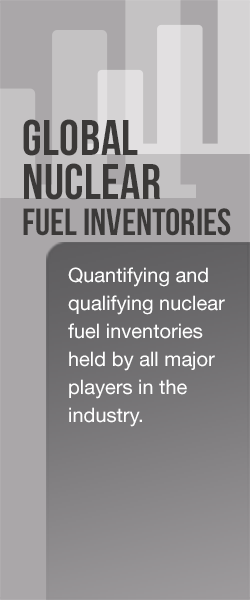The Rise of Secondary Demand
The uranium market has been shaped by secondary supplies (i.e., supplies that are not directly sourced from mine production) for many decades. In fact, since 1990, there has not been a single year when total mine production met annual reactor fuel demand. Thus, the importance of secondary supplies in balancing the market cannot be understated. On the other side of the ledger, uranium demand has traditionally always been defined by the fuel requirements to keep nuclear power plants running around the world. Even when non-utilities (e.g., producers or intermediaries) enter the market to purchase uranium, this is typically done to cover deliveries that are ultimately intended for end users, such as Cameco’s large spot purchases since 2017. Naturally, the spot market has some amount of “churn” between traders and other intermediaries, but UxC’s detailed analysis shows that this only represents between 30% and 40% of total spot volume in any given year. Thus, to date, it is accurate to say that most uranium demand has been dictated by the needs of the global reactor fleet. However, recent developments may indicate that a new kind of “secondary demand” could be emerging that, if large enough, has the potential to dramatically reshape the uranium market for years to come.
Non-end user buying of uranium is, of course, nothing new to the market. In fact, from 2004-2011, UxC tracked purchases by several hedge funds as well as the establishment of two investor funds – Uranium Participation Corp. (UPC) and Nufcor Uranium Limited (NUL) – which together held a net total of around 26 million pounds U3O8e at their peak. However, these entities for the most part disappeared from the market after 2011. The only player that remained active was UPC, which had previously merged with NUL. However, this changed in 2018 with the entry of Yellow Cake plc (YCA) as well as a few new hedge funds. As seen in the chart, uranium-related holdings by funds roughly doubled over the course of 2018. 2019 saw some smaller additions to these holdings, but 2020 actually revealed some sales by financial firms. 2021, however, has already been very different. With the dramatic rise in investor interest in uranium that began late last year, capital has flowed into numerous hands with the express purpose of acquiring physical uranium. Thus, in just the first 125 days of 2021, UxC has tracked purchases by investment-related entities, including junior uranium miners without existing future sales commitments, totaling roughly 12.5 million pounds U3O8e. This includes the latest new purchases announced just last week by UPC (see story on page 11) as well as the recent purchase by Uranium Royalty Corp. (URC) of U3O8 from YCA. In total, UxC now estimates that financial and junior miner holdings combine for about 49 million pounds U3O8e. This increased volume is already unprecedented, but it could just be the beginning of a new trend.
For the most part, it is quite evident what is driving all of this uranium buying by financial and related players. There is a clear view within the investor community that uranium prices today are far too low to sustain production to cover future reactor fuel demand. Starting with the new funds that entered in 2018, these players have been betting on a rising uranium price, but the developments of the past 4-6 months have accelerated this trend and put it in overdrive. Several well-placed individuals tied into both the uranium and investment communities have recently told UxC that they have never seen anything like the kind of money flows entering the uranium space in recent months. Large institutional investors began taking a second look at uranium around the start of Q4 2020, and they liked what they saw. Retail investors have also jumped onto this story, as evidenced by the huge uptick in social media commentary. There appears to be a consensus forming among bullish uranium investors that nuclear power will become a bigger part of the global clean energy/ESG push to mitigate climate change, and thus demand for uranium will rise significantly. Moreover, these investors generally believe that uranium is underpriced today with only further upside given a consistent lack of sufficient investments in new mines to satisfy future rising demand.
It is difficult to estimate the total amount of money that has flowed into the uranium space over the past half year, but the numbers appear to be quite astounding. Combining direct capital raisings by uranium-related companies along with the huge increase in money flows in uranium equities (see top right chart), UxC estimates that at least $1 billion in new money has been invested in uranium in the past six months with the majority of that appearing just since February.
This brings us to the news we reported last week (UxW35-18) that Sprott Asset Management has agreed to acquire UPC and transform it into a new physical uranium trust that it intends to list on both the Toronto and New York stock exchanges. Sprott is a well-established, global investment manager specializing in precious metals and real assets, and, as John Ciampaglia, CEO of Sprott Asset Management stated, “We believe our global brand, fund marketing experience, and client base of more than 200,000 investors will improve trading liquidity and grow UPC’s asset base during what we believe is the start of a bull market for physical uranium.”
Assuming that the Sprott acquisition is concluded around July of this year, the new uranium trust could begin to see large inflows of additional capital once it starts operating. The differences between the current UPC structure and the envisioned new trust structure are significant. Not only will Sprott likely expand its reach to investors, especially if it lists on the New York Stock Exchange, but it is also expected to operate in a way that allows it to regularly issue to shares (i.e., trust units) thus enabling the trust to raise capital much more frequently than the onerous process facing today’s UPC. For example, UPC tends to require a premium to its net asset value (NAV) of 10-15% before it can raise funds to buy more uranium. The Sprott trust could reduce this NAV premium trigger point to just 2-4%. Sprott is also expected to create an “at-the-market” (ATM) offering program, which will further simplify the process of raising money regularly to allow it to procure additional pounds of U3O8, which is the way that the fund gets back into alignment with its NAV. Thus, with a wider investor reach and more efficient mechanism to regularly raise large sums of money, the new Sprott trust has the potential to be a more frequent buyer of spot uranium.
It is still too early to reach any definitive conclusions about the implications of this new Sprott uranium trust for the broader uranium market, but we can already begin to see the possibilities. Considering that ~$1 billion has already flowed into this market in recent months, and much of that has been geared towards spot uranium purchases already, there is clearly a strong appetite on the part of investors to expand their uranium-related investments. Some well-placed individuals have told UxC they estimate another $1-$2 billion could enter this market in the coming 12-24 months considering the ongoing push for nuclear to be included in ESG investments. Since many junior miners have already raised enough money to continue their exploration and development programs, investors will be looking for new avenues to place their money in our relatively small uranium sector. Thus, a liquid asset like the Sprott uranium trust could be the perfect fit.
If and when Sprott takes over UPC this summer, we would expect there to already be a sizeable amount of money ready to be put to work in procuring new uranium assets. Over time, depending on the trend of uranium prices and interest among investors, there is potential for momentum to build behind the Sprott trust and even more uranium to be purchased. This new trust could result in sizeable new demand for spot uranium. In fact, a doubling of the current UPC holdings is certainly not out of the question, although it might take some time before such large numbers are reached.
Some may argue that they have seen this before and that financial entities are prone to liquidate their holdings in the future, either to lock in profits or for other reasons, such as when the 2008 financial crisis forced several hedge funds to sell all their assets. While some of the current holdings are certainly likely to return to the market in the future, it remains difficult to predict the timing of any such sales. The junior miners have already indicated plans to hold onto their uranium for several years with the aim of using the assets to support future capital requirements to develop their mines and to backstop future contracts with utilities. Some hedge funds are also known to have placed their material into carry-trades with deliveries to utilities out in time. However, the investment funds (i.e., UPC/Sprott and YCA) are much less likely to sell large volumes of material given the impact this has on their share prices. In fact, over the past 15 years, UxC has recorded less than 1.5 million pounds U3O8e in total from investment funds re-entering the market. Sprott’s other trusts, which are in precious metals, are not known to be frequent sellers of their holdings, and we would expect this to be similar for the new uranium trust. Meanwhile, YCA does have an agreement with Kazatomprom that allows KAP to repurchase roughly 2 million pounds U3O8 if the Ux U3O8 spot price reaches $37.50/lb, but this is again a relatively small quantity. Thus, we would not be surprised to see a percentage of the uranium held by financial entities returning to the market, but we caution against believing this material will definitely be available in the future the way inventories built up by producers and traditional intermediaries have recently been used to replace production or put into mid-term carry-trades.
Ultimately, the growth in what we are terming “secondary demand” truly has the potential to alter the nature of the uranium market in profound ways. If the new Sprott trust becomes a consistent buyer of spot uranium, we could see this translating into a “standing bid to buy” that has not existed heretofore in our often illiquid market. Any seller looking to move material would have more confidence about where to place pounds, and thus might be less incentivized to heavily discount material. The resulting increased liquidity could also improve price discovery, which we at UxC would welcome. However, there are also possible ramifications that traditional market participants must be fully aware of. For one, the large amount of buying in the spot market since COVID-19 hit in March 2020 has already created a tighter spot market. Thus, the predicted expansion of secondary demand from the new Sprott trust and other financials, including hedge funds, YCA, URC, etc., could result in spot uranium supply falling even further. This could consequently propel spot prices quite a bit higher than current levels.
Spot market demand dictated by reactor needs has tended to be quite predictable over the years, and even recent increased buying by producers to cover mine closures has been finite. However, the new secondary demand is financially driven, and as such, is much more unpredictable and volatile, making it significantly more difficult to forecast. This previously unanticipated layer of uncertain demand has the potential to notably shift spot uranium market fundamentals. All market participants would be wise to pay close attention to these new developments.


